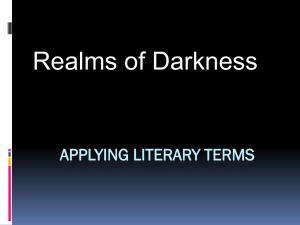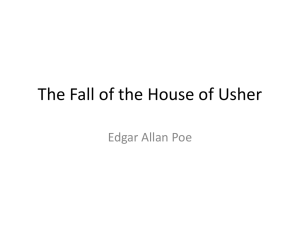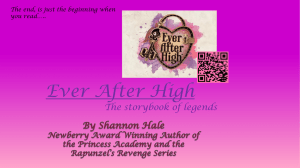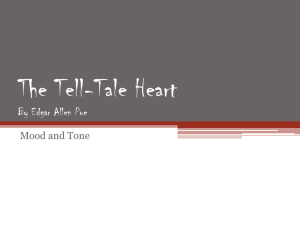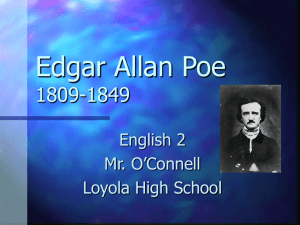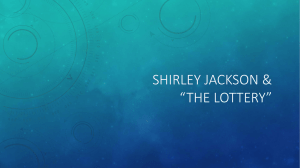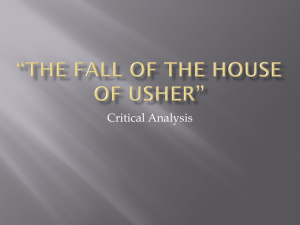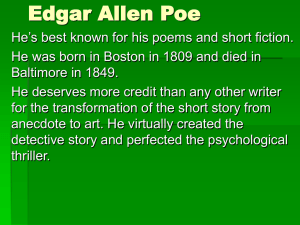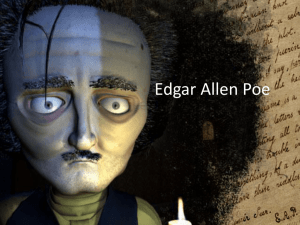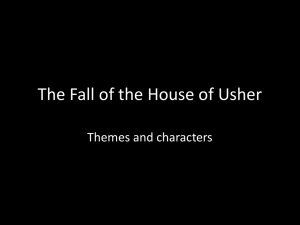The Raven - mrssnydersclassroom
advertisement
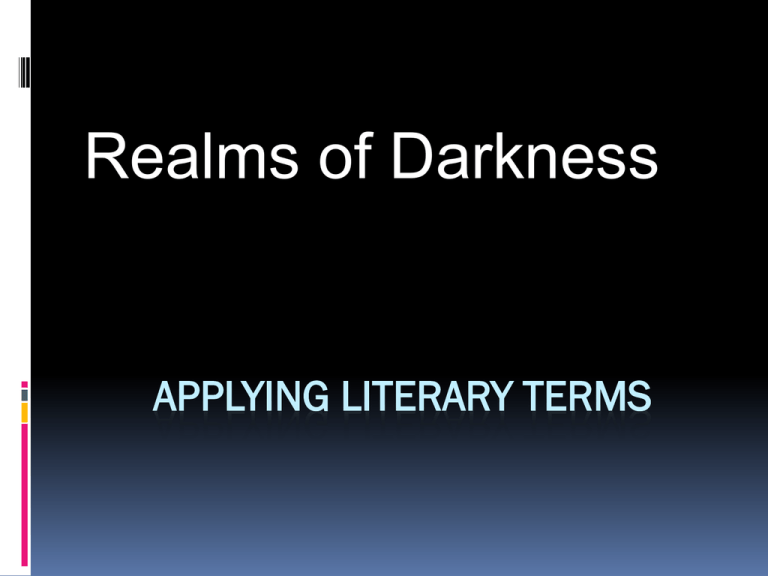
Realms of Darkness APPLYING LITERARY TERMS The Dark Side American Romanticism 1828-1865 Similar to Transcendentalism: Interested in spiritual Intuition/imagination over reason Exploration of mystery of human existance Different from Transcendentalism: Didn’t believe in inherent “good” in man- saw madness, evil, and alienation as driving forces of human spirit Gothic Fiction Creates a haunting/supernatural atmosphere (use of imagery) Includes strange/chilling events, torture, resurrection Explores unsettling, irrational depths of mind Purpose of Gothic Fiction To show the madness and violence underneath the seemingly peaceful surface of civilization Allegory: A symbolic story that serves as a disguised representation for meanings other than those indicated on the surface. The characters in an allegory often have no individual personality, but are embodiments of moral qualities and other abstractions. (Abstractions are ideas/concepts that aren’t physical. Ex: love, freedom, moral, success. Ex –”isms”: racism, feminism, sexism). Allegory in Nathaniel Hawthorne’s “Dr. Heidegger’s Experiment” Dr. Heidegger=God-figure (all knowing, all powerful) Dr. Medbourne=greed Colonel Killigrew=lustful/gluttonous Madame Wycherly=vanity Mr. Gascoigne=dishonesty Edgar Allan Poe, Nathaniel Hawthorne, and Gothic fiction “Dr. Heidegger’s Experiment” Setting contains elements of the supernatural- faces of the dead appear in mirror; décor is ancient and mysterious Characters undergo magical transformation and illustrate follies of human nature “The Fall of the House of Usher” Poe creates a dark and foreboding atmosphere: a rotting mansion, mysterious illnesses, and a person buried alive to name a few Ravens as symbols Raven: A glorified black crow. It can be be up to two feet long and eats small animals (roadkill!), fruit, and seeds. They often appear in legend and literature as sinister omens. What’s “The Raven” about? The death of a beautiful woman, Lenore, as lamented by her bereaved lover. Who is Lenore? It is possible that Lenore represents Poe’s beloved wife, Virginia, who was in poor health when Poe wrote "The Raven." She died in her mid-twenties, just two years after the publication of the poem. Setting: The “chamber” of a house at midnight. Poe uses the word “chamber” rather than “bedroom” because chamber has a dark and mysterious connotation. Poe uses words to create atmosphere: The importance of word choice: Poe is careful to use primarily words that contribute to the overall atmosphere and tone of his work. In The Raven, examples include: weary, dreary, ghastly, ebony, sorrow A musician at heart? The Raven has a musical sound and rhythmic pattern created through the use of: internal rhyme, end rhyme, and alliteration, repetition (refrain) Alliteration Repetition of consonant sounds “Doubting, dreaming dreams no mortal ever dared to dream before;” (Edgar Allan Poe’s The Raven) Internal Rhyme- 2 forms: 1. Rhyme that occurs within a line of poetry “Once upon a midnight dreary, while I pondered, weak and weary.” (The Raven) The rhyme is within one line! Example: Eminem and Rihanna, Love the Way You Lie “And right now, there’s a steel knife in my windpipe. I can’t breathe, but I still fight while I can fight. As long as the wrong feels right it’s like I’m in flight.” Internal Rhyme, continued 2. Rhyme can also occur in the middle of 2 or more consecutive lines of poetry: “And right now, there’s a steel knife in my windpipe. I can’t breathe, but I still fight while I can fight. As long as the wrong feels right it’s like I’m in flight.” Refrain The repetition of a phrase or line, usually at the end of a stanza Stanza’s 3-7 of The Raven end in “nothing more” Onomatopoeia A word’s sound that imitates its meaning The rusty spigot sputters, utters a splutter, and spatters a smattering of drops. (Also, personification and alliteration used here ). Also, repetition of above “S” sound creates onomatopoeia (sssssss sounds like running water) Line 13 of The Raven “silken, sad, uncertain, rustling” (of curtains). Criticisms of The Raven Some reviewers in Poe’s day, including poet Walt Whitman, criticized “The Raven” for its sing-song, highly emotional quality. The poem is still criticized for the same reason, often in the form of parody (The Simpsons). However, the consensus of critics and ordinary readers appears to be that the poem is a meticulously crafted work of genius and fully deserves its standing as one of the most popular poems in American literature. “THE FALL OF THE HOUSE OF USHER” POE 1839 Elements of Gothic Writing in “Usher:” Emphasis on setting Exterior: landscape Interior: houses Castle-like architecture Characters are brooding, secretive Buried family secrets Long history of family tied to place Gothic Architecture in America Started in US about 1840 Steeply pitched roofs Pointed arch windows Elaborate trim around roof edges Poe’s “house of Usher” looks more like a medieval castle or English cathedral in Gothic style The house might look something like this (from a photograph by Simon Marsden in his Visions of Poe) The house as a symbol The “house of Usher” has two meanings The physical dwelling 2. The family line, or lineage, and the split in the family 1. – “the entire family lay in the direct line of descent” The Doubling Motif In literary criticism, this is called a “doppelganger,” from the German for “double-goer” Representations of the Doppelganger: A doppelganger is a double or second-self. In literature, the Doppelganger is often figured as a twin, shadow, or mirror-image of the protagonist. The Doppelganger characteristically appears as identical to (or closely resembling) the protagonist; sometimes the protagonist and Doppelganger have the same name. Purposes of the Doppelganger: I. One form of the Doppelganger motif is the “psychomachia,” which depicts "conflict within the soul" or the struggle between virtue and vice within an individual. Separate characters represent different aspects of a single human personality. Conflict within the drama depicts either: the struggle of conscience or, the need for integration of the personality. As seen in “Usher,” Roderick struggles with his conscience (specifically, with a choice he made). Example of Doppelganger in “Twilight” Jacob struggles to accept and integrate his new second identity, the werewolf: http://www.youtube.com/watch?v=XBnEwthMphE Purposes of the Doppelganger, contd: II. The Doppelganger represents hidden or repressed aspects of the protagonist's personality. The arrival of the double represents the "return of the repressed." The protagonist must acknowledge what the double represents, and at the same time struggle against it. In “Usher,” Madeline’s reappearance after breaking out of her tomb represents the return of Roderick’s repressed self. Purposes of the Doppelganger, contd: III. Often, a Doppelganger story climaxes with a confrontation of the two, usually a fight to the death. The death of the Doppelganger represents the successful repression of the dangerous impulses, but the struggle leaves the protagonist sadder and wiser about humanity and about himself or herself. Madeline kills Roderick and in doing so, kills herself as well. So, Who Represents What? Roderick- reliance on mental Madeline-reliance on physical Roderick Roderick’s mental condition is affected by his environment “He was enchanted by certain superstitious impressions in regard to the dwelling which he tenanted . . . An effect which the physique of the gray walls and turrets, and of the dim tarn into which they all looked down, had, at length, brought about upon the morale of his existence.” Here, “physique” refers to something physical And “morale” refers to something mental Roderick is all mind in a weak body He represents in one way the life of the isolated artist Paintings Reading Guitar playing Madeline Illness has debilitated her, adding to Roderick’s loneliness All descriptions focus on the body “gradual wasting away of the person” She returns from the tomb to reclaim her twin brother, her “double,” representing her strong mental will. What is Poe’s point? Poe addresses the dual and conflicted nature of the Self Mind and body are at war with each other in each of us We try to repress one side and live without it But we cannot achieve a harmonious existence in this way Stream of Consciousness writing (“interior monologue”) Characterized by a flow of thoughts and images, which may not always appear to have a coherent structure or cohesion. The plot line may weave in and out of time and place, carrying the reader through the life span of a character or further along a timeline to incorporate the lives (and thoughts) of characters from other time periods. Focuses on the emotional and psychological processes that are taking place in the minds of one or more characters, revealing important character traits. Example, taken from Ambrose Bierce’s “An Occurrence at Owl Creek Bridge:” He unclosed his eyes and saw again the water below him. "If I could free my hands," he thought, "I might throw off the noose and spring into the stream. By diving I could evade the bullets and, swimming vigorously, reach the bank, take to the woods and get away home. My home, thank God, is as yet outside their lines; my wife and little ones are still beyond the invader's farthest advance.” Common examples of “stream of consciousness” are brainstorming charts and journal writing. Making inferences “Inference” is simply an educated guess based on facts and your own knowledge. An important skill when reading literature is making inferences or “reading between the lines:” Go beyond the surface details to see other meanings that the details suggest or imply (not stated). Choosing the most likely explanation from the facts at hand. You enter class and your teacher says: “Clear your desks of everything but a sheet of paper and a pencil.” What would you infer is about to happen? Making inferences and “A Rose for Emily” Certain details in the text that seem to describe one thing can actually help us understand Miss Emily better (description of her funeral suggests she was once important). Sometimes details that are left out of the writing help us understand her, too (no mention of people’s feelings for Miss Emily indicate she led a lonely life). Turn to page 875 for a brief reading/activity. Metaphor By now you all should know the simple definition of metaphor... “a comparison not using ‘like’ or ‘as’.” However, some metaphors are not stated directly, they are hinted at. An “implied metaphor” is a comparison between 2 unlike things that is suggested but not stated directly. Implied Metaphor in The Death of the Ball Turret Gunner The gunner in the poem is referred to as both a newborn infant a helpless animal What words develop this implied metaphor? (See poem, page 1040) Answers: Newborn: “mother’s sleep” “belly” Helpless animal devoured by (taken advantage of) the government: “fell into the State, hunched in its belly” “wet fur froze” Imagery The use of descriptive details and sensory images to evoke a picture, feelings, or a concrete sensation. The Death of the Ball Turret Gunner: What it says: What you picture: Feelings evoked: “I fell into the State” Tumbling backwards Helplessness, fright, confusion “And I hunched in its belly till my wet fur froze.” “When I died they washed me out of the turret with a hose.” Post-reading ideas/themes we are left with: Poem illustrates soldier’s courage, bravery Soldiers actions are “born” (relates to newborn metaphor) of the ever-powerful government, the institution that controls them. Soldiers, by comparison, are powerless. The senselessness of a young man’s death. War is brutal and ugly- it is not the glorious adventure it is sometimes depicted as. Society becomes desensitized to soldiers’ deaths (corpse is casually washed out with a hose). Irony By now you should know some basic definitions of irony: When the opposite of what you expect to happen occurs (situational) Saying the opposite of what you mean (verbal) When audience knows more than character (dramatic) A basic definition of irony is when there is a discrepancy between appearances and reality. Tone Reflection of the writer’s attitude, manner, mood, and/or moral outlook in his work. Think about the different tones of voice parents might say these words in: What is said: Tone: Come inside, please. Calm, polite Get your butt in the house right this instant, young man! Frustrated, angry A tone pervades written words just like spoken ones! Mood The mood is the overall feeling or emotion that a literary work arouses in its reader. Mood is usually summed up in one or two adjectives, such as pessimistic or hopeful. Mood and tone are closely intertwined. The writer’s tone can certainly affect the mood of the piece. The best way to understand how they are different is to understand that the tone is a reflection of the writer’s beliefs whereas the mood of a work is interpreted and felt by each individual reader. Irony and Tone in Because I Could Not Stop for Death A basic definition of irony is when there is a discrepancy between appearances and reality. Part of the success of this poem rests on this definition. Dickinson personifies Death in a manner that is opposite to what most people think about death: Death appears harmless , civil, polite even. This is contrary to the general belief (or reality) that death is a scary and/or sad event. This contributes to a certain tone in the poem–Death is the narrator’s carriage driver and appears lighthearted yet imminent (tone). If Death is personified as civil and polite, it doesn’t appear sorrowful, scary, or evil as people (in some cultures) view death. Dickinson’s tone of lightheartedness helps establish a light mood. Brainteaser time! This discrepancy between our feelings of Death in the poem versus our feelings about the subject of death is also a part of the irony of this poem! Just for fun THE END… And this concludes our “Realms of Darkness” notes!
